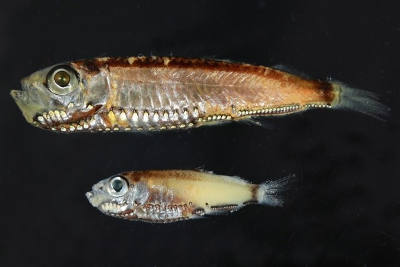Digital wellbeing should be a public health priority for the Arab region
21 October 2025
Published online 17 March 2018
Cells in the retina of deep-sea fish species may be adapted for twilight vision

© Fanny de Busserolles
The retinas of humans and most other vertebrates have two types of light-sensitive cells, cones for daylight and rods for low-light. Many species that are active during only night or day have lost one of the types, leaving them with retinas composed entirely of rods or cones.
Like many other deep-sea fish, pearlsides have long been thought to have pure rod retinas adapted to living in darkness far below the surface. But pearlside behaviour “is very different from other deep-sea fishes,” says Fanny de Busserolles, who started the research project at Saudi Arabia’s King Abdullah University of Science and Technology before moving to the University of Queensland in Australia. “They only migrate to the surface at dusk and dawn, so they experience different light conditions than other deep-sea fish,” who spend the entire night at the surface. The researchers were curious why fish which are active at twilight have retinas seemingly adapted to darkness.
Pearlside retinal cells were classified as rods based on their shape in microscope studies. However, when the team analysed the genes expressed in the cells, they found genes for the light-sensitive pigments of cones.1
At medium light levels such as twilight, humans use rods and cones together, resulting in functional but poor vision. The team believes that pearlsides have evolved a more efficient approach combining the light-gathering ability of rod-shaped cells with the visual performance of cones.
These cells may be ideally adapted for vision at twilight, although further tests are needed to confirm the hypothesis.
The discovery made the behaviour of pearlsides much clearer to the team, which also included researchers from the University of Western Australia and Norway’s University of Bergen. “The more you understand about how an animal perceives its environment and integrates information, the more you can interpret its behaviour. It helps you put yourself in the animal’s skin and understand why it lives and behaves the way it does,” says de Busserolles, adding that this can help scientists better understand and protect ecosystems.
Cells combining the features of rods and cones have been seen in other species, such as geckos and snakes, but the known cases all involve species which have lost one cell type and modified the remaining type to regain the lost function. Pearlsides haven’t lost either rods or cones; the retinal cells of adults look like rods, but the fish also have cones at other stages of life.
The team thinks that these cells changed in pearlsides as an adaptation to their specific environment rather than to regain lost functions.
“That’s what makes them so particular,” says de Busserolles. “Deep-sea fishes continue to surprise us with how they adapt to be successful in this extreme environment. The more we look, the more discoveries we make and crazy adaptations we find.”
doi:10.1038/nmiddleeast.2018.27
Stay connected: